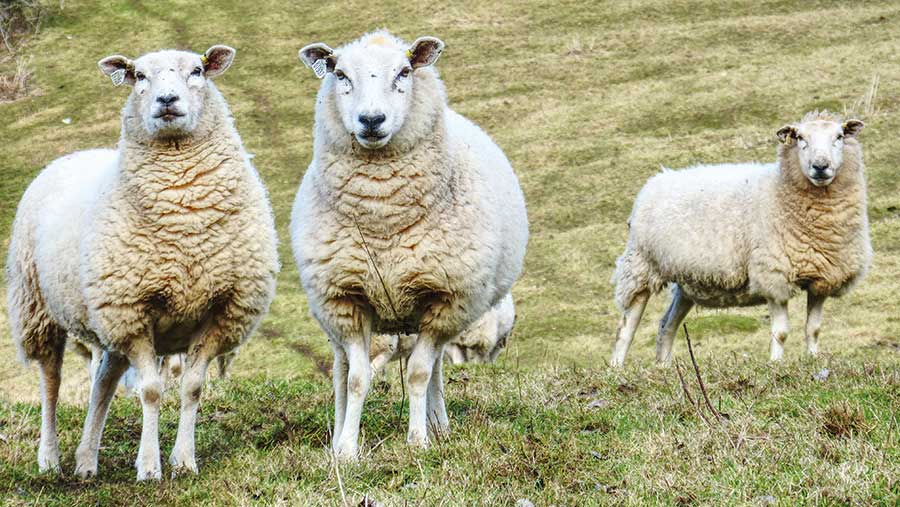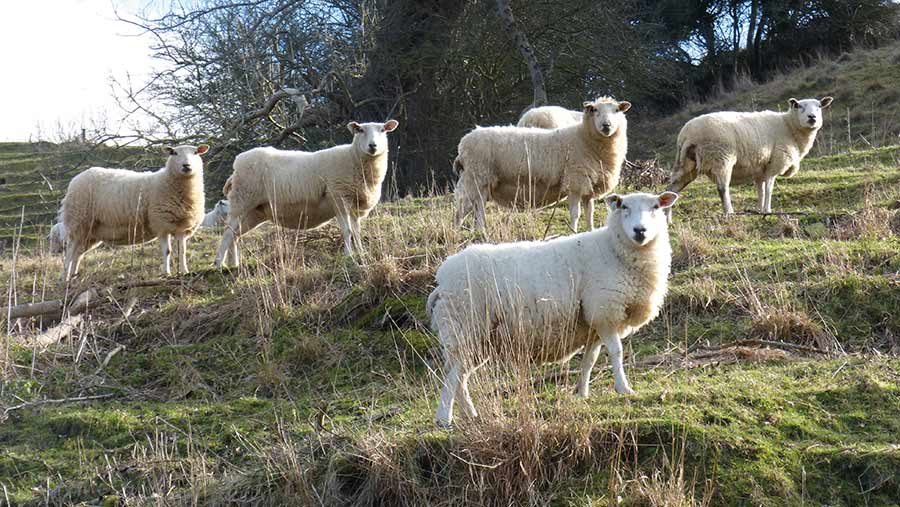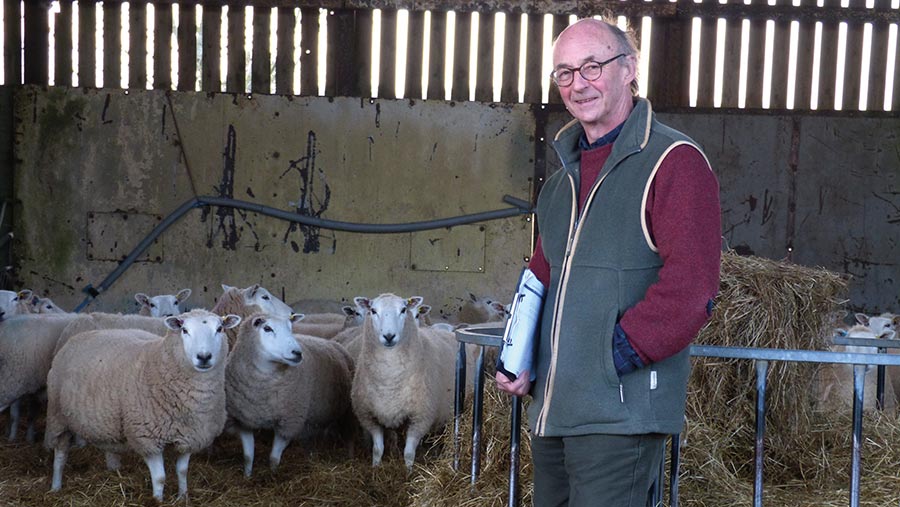Why demand is hotting up for worm-resistant rams
 The Sundance Lleyn flock © MAG/Michael Priestley
The Sundance Lleyn flock © MAG/Michael Priestley Sheep breeders are selling rams with parasite resistance attributes after finding 35% heritability for the trait through a blood test.
And growing numbers of commercial sheep farmers are seeking rams with high estimated breeding values (EBVs) for parasite resistance to cut dosing and lower their farm’s worm burden.
See also: Sheep blindness warning issued on overdosing with closantel
The EBVs (see “Latest benchmarks for Lleyn parasite resistance traits”) have been launched 10 years after 25 Lleyn breeders formed the Performance Recorded Lleyn Breeders group, marshalled by Somerset farmer George Cullimore.
How is the resistance found?
Initially, the only route to finding sheep that shed fewer eggs was faecal egg count (FEC) scoring.
A false dawn then followed when testing saliva for antibodies proved to have low heritability.
This research was inspired by immunogeneticist Mike Stear at Glasgow University and trialled at Harper Adams by sheep expert Kate Phillips.
Recent trials have found that testing blood samples for antibody response to the parasitic stage (L4) of the strongyle Teladorsagia circumcincta produces very promising results on lambs in late summer.
The blood test – known as serum IgA – is offered by Biobest, Edinburgh, at £7.50 a sample. AHDB offers funding of £5/sample.
How are sheep resistant?
Scientists believe lambs achieve resistance by limiting the ability of worms to feed. Their immune response changes the stomach lining, making it harder for worms to latch on and decreasing their size.
Shorter worms are less parasitic, produce fewer eggs, and the eggs they do produce are less viable. However, more research and postmortem work is needed to clarify how lambs become resistant.
Some flocks have reported saving one dose a year purely through genetics.

© MAG/Michael Priestley
Breeders, not farmers
Selecting for sheep with parasite resistance requires a breeder’s approach to challenge ewes, rather than a farmer’s approach to fast lamb finishing, experts say.
Lambs must be exposed to the worm and have a high enough egg count for variation between individual animals to be expressed.
This can be determined by taking a mob FEC sample with a worm count of more than 300 eggs/g.
The antibody response is most reliably measured in older lambs. The ideal time for a March-born lamb is in September or October, when the lambs are being back-fat scanned by Signet.
Industry take up
As well as Lleyns and Exlanas, some Romney and Easycare flocks have started sampling for parasite resistance, as have Welsh flocks in the Hill Ram Scheme.
How do I breed for parasite resistance in my sheep?
To breed for parasite resistance in the Performance Recorded Lleyn Breeders Signet index, breeders can select for:
- Faecal egg counts (FEC) (strongyles): Negative figures denote strongyle resistance and fewer worms excreted onto pasture.
- FEC (nematodirus): Negative figures denote a nematodirus resistance, with fewer worms excreted onto pasture.
- Serum IgA: An indicator (from blood testing) of immune response when challenged by gastrointestinal parasites.
- Parasite Plus: An index bringing together FEC values and Serum IgA. By buying a high Parasite Plus ram, you will benefit in the first crop of progeny as they should show high immune response to worm infection, shed fewer eggs and potentially need fewer anthelmintic treatments.
Latest benchmarks for Lleyn parasite resistance traits |
||
|
Trait |
Top 1% |
Average |
|
Faecal egg count (FEC) (strongyles) |
-0.68 |
0.2 |
|
FEC (nematodirus) |
-1.02 |
-0.11 |
|
Serum IgA |
-0.15 |
-0.03 |
|
Parasite Plus |
104 |
76 |
| Source: AHDB, Signet | ||
Case study: Somerset flock now selling rams for parasite resistance

George Cullimore © MAG/Michael Priestley
Aiming for labour efficiencies, cost control and anthelmintic stewardship has driven a Somerset farmer to spend 10 years at the forefront of parasite resistance breeding.
George Cullimore of Coombe Barn near Bath is synonymous with the art of breeding sheep resistant to gastrointestinal parasites.
Along with other members of the Performance Recorded Lleyn Breeders group, he has purposefully run high worm burdens on his farm and invested many hours sampling dung.
Sundance Lleyn
- 150 Signet-recorded Lleyn ewes
- 28ha (70 acres) of grassland and 20ha (50 acres) of woodland
- Sells 12 rams a year
- Steep banks and grass parks
- Extensive outdoor lambing
- White wormer only works for nematodirus
- Yellow and clear wormers still work for later-season parasites
The current serum IgA test means FECs are no longer necessary, but Mr Cullimore continues to do FECs as an experimental control alongside serum results, such is his commitment to the project.
If lambs “tick over”, growing at 200-250g/day, that is considered a good performance, as egg counts are kept high (about 400-500 eggs/g) to challenge lambs.
Labour saver
In 2001, Mr Cullimore had a life-threatening accident when he got wrapped around a rear tractor wheel. He still finds walking and long days on the farm difficult.
The family had recently bought the farm from the Neeld Estate, was running 700 ewes and had hoped to build up to about 1,000 ewes.
“My injury made me realise how hard some jobs are,” he explains.
“Dosing lambs is time-consuming, and breeding can be one of the tools to reduce the workload. I’m also using a few wool-shedding rams to look at cutting shearing out, too.”
Case study: Parasite resistance is route to lower-emission lamb

Simon Thompson © MAG/Michael Priestley
A Derbyshire Lleyn breeder is in a strong position to select for parasite resistance after buying rams that turned out to have strong breeding values for the trait.
Simon Thompson of Culland Hall, near Ashbourne, says parasite resistance will help unlock the chemical, labour and efficiency challenges facing sheep production.
Mr Thompson has started selecting rams and females in the top 5-10% for the trait. He is hoping to sell six rams next summer in the top 10% for the serum IgA EBV and a further six in the top 25%.
Culland flock
- 310 Lleyn ewes
- 68ha (170 acres) plus winter grazing on a further 68ha
- Typically scanning at 190-200%, but scanned at 170% this year after the drought
- Farm is mostly unimproved grassland with white clovers
- Herbal ley trialled last year
- Selling 200 shearlings and 15-20 shearling rams a year
Drive home the advantage
He has bought two rams with high parasite resistance from the Nellesses at Thistleyhaugh, Northumberland, to build on this advantage.
He aims to manage parasites with breeding rather than anthelmintics in his Culland flock, and pass the benefit on to his customers.
Mr Thompson takes a big-picture view and sees the temperate climate and productivity of UK farmland as a massive export advantage over increasingly dry southern Europe, north Africa and the Middle East.
He says estimated breeding values for parasite resistance should convey the following advantages:
- Labour savings: Less time spent managing lambs later in the season that have had growth and finishing delayed by parasites
- Wormer efficacy: Chemical use will drop, and frequency and volume of doses should help keep wormers working
- Lower greenhouse gas emissions: Mr Thompson cites an article in the International Journal of Parasitology (2018) that showed a parasite infection could lead to a 33% increase in methane emissions from lambs in less efficient systems with more time spent on pasture.
